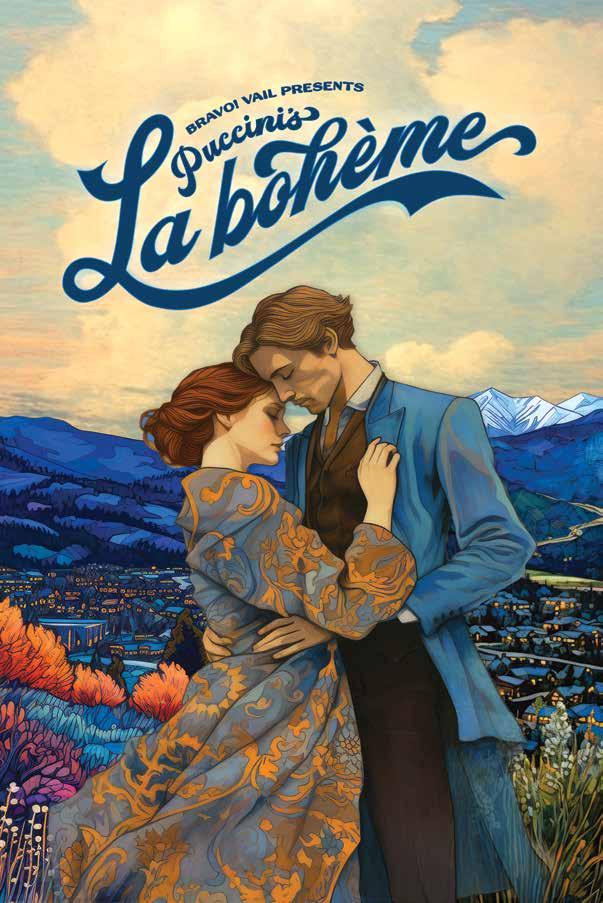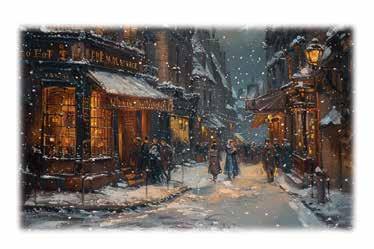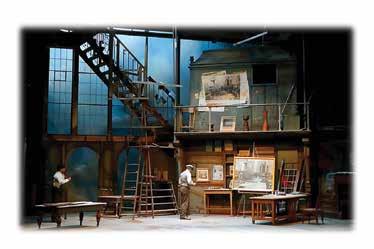

WELCOME
Welcome to Bravo! Vail Music Festival’s second ever production of an opera! Five years ago, we took a giant leap of faith with our production of Puccini’s Tosca, and, as they say, “the rest is history.” Who can resist the magic of musical storytelling that is opera when the inspired conductor Yannick Nézet-Séguin offers to lead a brilliant cast with the incomparable Philadelphia Orchestra? Thanks to the generosity of many, as well as the talents of a skilled team of directors, designers, technicians, and staff, we are filled with gratitude and excitement as we invite you to enjoy Puccini’s timeless love story, La bohème.
 Anne-Marie McDermott
Caitlin Murray Artistic Director Executive Director
Anne-Marie McDermott
Caitlin Murray Artistic Director Executive Director



BRAVO! VAIL

DIRECTOR’S NOTE
Throughout my career in opera, people have asked, “Which opera should I be sure to not miss?” Or, “Which opera should I bring my friend, cousin, mother, etc. to see for the first time?” My answer, always and without hesitation is La bohème. Bohème is the perfect first opera and the perfect one to view time and time again. Its story of a group of artists struggling with life, love, and paying the rent, is masterfully told with gorgeous music and soaring melodies. Each moment is scored in a way that carries the audience on a journey from comedy to tragedy, from a romantic first love encounter on Christmas Eve to a tragic heartbreak in springtime Paris. My first opera as an audience member? La bohème at the New York City Opera many years ago. Sitting in the balcony during Act III, I was brought to tears that did not stop until long after the final act curtain. I was a mess! I still get chills and remember the feeling when I hear that music. I hope, whether you are seeing La bohème for the first time, or the 50th, that you experience the extraordinary joy that only comes when live music is performed right in front of you!
- Paula Suozzi
1

THE LA BOHÈME CIRCLE
This opera production has been made possible by the generosity of the La bohème Circle Donors
LA BOHÈME PERFORMANCES ARE PRESENTED BY:
The Berry Charitable Foundation
Betsy Wiegers
PREMIER BENEFACTOR
Cathy Stone
FIRST CHAIR
John Dayton
The Betsy Wiegers Choral Fund, in Honor of John W. Giovando
IMPRESARIO
Anonymous
Dierdre and Ronnie Baker
Barbara and Barry Beracha
Gina Browning and Joe Illick
Virginia J. Browning
Ellie Caulkins
Vera and John Hathaway
Marcy and Stephen Sands
OVATION
The Therese M. Grojean Vocalist Fund
Anne and Hank Gutman
Jessica Levental and The Igor Levental Memorial Music Fund
ALLEGRO
Kjestine and Peter Bijur
Doe Browning and Jack Hunn
Kathy Cole
Vivien and Andrew Greenberg
June and Peter Kalkus
Judy and Alan Kosloff
Wendi and Brian Kushner
Amy and Hal Novikoff
Amy and James Regan
Susan and Richard Rogel
Sally and Byron Rose
Eva and David Schoonmaker
Carole and Peter Segal
Marilyn and James H. Steane, II
Dhuanne and Douglas Tansill
Carole A. Watters
Nancy and Harold Zirkin
2 BRAVO! VAIL

BRAVO! VAIL MUSIC FESTIVAL
2024 SEASON
Wednesday, July 10 • 6:00PM Friday, July 12 • 6:00PM
THE PHILADELPHIA ORCHESTRA
GIACOMO PUCCINI’S LA BOHÈME
Conducted by Yannick Nézet-Séguin
Paula Suozzi, Stage Director
Noele Stollmack, Production and Lighting Designer
Libretto by Luigi Illica and Giuseppe Giacosa
After Henri Murger’s novel Scènes de la vie de Bohème
PARIS, FRANCE, 1830s
ACT I
Christmas Eve, Latin Quarter Garret
ACT II
That same evening, Café Momus
INTERMISSION
At approximately 7:10PM
ACT III
At dawn, a few months later, Barrière d’Enfer, a toll gate on the edge of Paris
ACT IV
Months later, Latin Quarter Garret
Performed in Italian with English supertitles
This program runs approximately two hours, 30 minutes and will be performed with one 25 minute intermission.
3

IN ORDER OF VOCAL APPEARANCE
Étienne Dupuis, baritone Marcello, a painter
Stephen Costello, tenor Rodolfo, a poet
Krzysztof Bączyk, bass Colline, a philosopher
Alexey Lavrov, baritone Schaunard, a musician
Donald Maxwell, baritone Benoit, a landlord
Nicole Car, soprano Mimì
Joshua Zabatta, tenor Parpignol
Donald Maxwell Alcindoro, a councilor of state
Gabriella Reyes, soprano Musetta
Bravo! Vail Festival Chorus Duain Wolfe Director
Colorado Children’s Chorale Emily Crile Artistic Director
COVERS
Karen Chia-ling Ho, soprano (Mimì); Caitlin Gotimer, soprano (Musetta); César Delgado, tenor (Rodolfo); SeungHyeon Baek, baritone (Marcello); Benjamin Taylor, baritone (Schaunard); Ben Brady, bass-baritone (Colline); Bret Thom, baritone (Benoit); Zeky Nadji, baritone (Alcindoro)
4 BRAVO! VAIL

PRODUCTION
Shannon Gonzalez
Kate Redmond
Marty Bierman
Rick Jacobsohn
Andrew Poleszak
Ann Piano
Juan S Nuñez III
Tony Solitro
Ronald Mueller
Susan Sullivan
Jeff Rusnak
Z Craven
Luke Vlaar
Gabriel Baillargeon
Aaron Siegman
Kelly Gregson
Stage Manager
Assistant Stage Manager
Lead Audio Engineer
Front-of-House Audio Engineer
Costume Designer
Assistant Costume Designer
Hair and Makeup Designer
Supertitles
Props Master
Video Director
Scenic Builder
Stage Audio Tech
Audio Assistant
Audio Assistant
Assistant Lighting Designer
Draper
Thomas Martin & Nia Quan Stitchers
Elizabeth Porter
Alison Milan & Carolyn Miller
Lorilee Johnson
Ian Wells
Pierce Hammond & River Howell
Drew Howell
Dresser
Principal Wardrobe Crew
Hair & Makeup Assistant
Graphics Technician
Stage Assistants
Driver
5

SYNOPSIS
PARIS, IN THE 1830S
ACT I
In their Latin Quarter garret, the near-destitute artist Marcello and poet Rodolfo try to keep warm on Christmas Eve by feeding the stove with pages from Rodolfo’s latest drama. Soon, their roommates—Colline, a philosopher, and Schaunard, a musician—return. Schaunard brings food, fuel, and funds that he has collected from an eccentric nobleman. While they celebrate their unexpected fortune, the landlord, Benoit, comes to collect the rent. After getting the older man drunk, the friends urge him to tell of his flirtations, then throw him out in mock indignation at his infidelity to his wife. As the others depart to revel at the Café Momus, Rodolfo remains behind to finish an article, promising to join them later. There is another knock at the door: It is Mimì, a pretty neighbor whose candle has gone out in the stairwell. As she enters the room, she suddenly feels faint. Rodolfo gives her a sip of wine, then helps her to the door and relights her candle. Mimì realizes that she lost her key when she fainted, and as the two search for it, both candles go out. Rodolfo finds the key and slips it into his pocket. In the moonlight, he takes Mimì’s hand and tells her about his dreams. She recounts her life alone in a lofty garret, embroidering flowers and waiting for the spring. Rodolfo’s friends call from outside, telling him to join them. He responds that he is not alone and will be along shortly. Happy to have found each other, Mimì and Rodolfo leave, arm in arm, for the café.
6 BRAVO! VAIL
ACT II
Amid the shouts of street hawkers near the Café Momus, Rodolfo buys Mimì a bonnet and introduces her to his friends. They all sit down and order supper. Marcello’s former sweetheart Musetta makes a noisy entrance on the arm of the elderly, but wealthy, Alcindoro. The ensuing tumult reaches its peak when, trying to gain Marcello’s attention, she loudly sings the praises of her own popularity. Sending Alcindoro away to buy her a new pair of shoes, Musetta finally falls into Marcello’s arms. A parade of soldiers passes by the café as the friends join the crowd of revelers.
ACT III
At dawn at the Barrière d’Enfer, a toll gate on the edge of Paris, a customs official admits farm women to the city. Mimì arrives, searching for the place where Marcello and Musetta now live. When the painter appears, she tells him of her distress over Rodolfo’s incessant jealousy. She says that she believes it is best that they part. As Rodolfo emerges from the tavern, Mimì hides nearby. Rodolfo tells Marcello that he wants to separate from Mimì, blaming her flirtatiousness. Pressed for the real reason, he breaks down, saying that her illness can only grow worse in the poverty that they share. Overcome with emotion, Mimì comes forward to say goodbye to her lover. Upon hearing Musetta’s laughter, Marcello runs back into the tavern. While Mimì and Rodolfo recall past happiness, Marcello returns with Musetta, quarreling about her flirting with a customer. They hurl insults at each other and part, but Mimì and Rodolfo decide to remain together until springtime.
ACT IV
Months later in the garret, Rodolfo and Marcello, now separated from their lovers, reflect on their loneliness. Colline and Schaunard bring a meager meal. To lighten their spirits, the four stage a dance, which turns into a mock duel. At the height of the hilarity, Musetta bursts in with news that Mimì is outside, too weak to come upstairs. As Rodolfo runs to her aid, Musetta relates how Mimì begged to be taken to Rodolfo to die. She is made as comfortable as possible, while Musetta asks Marcello to sell her earrings for medicine and Colline goes off to pawn his overcoat. Left alone, Mimì and Rodolfo recall their meeting and their first happy days, but she is seized with violent coughing. When the others return, Musetta gives Mimì a muff to warm her hands, and Mimì slowly drifts into unconsciousness. Musetta prays for Mimì, but it is too late. The friends realize that she is dead, and Rodolfo collapses in despair.
—Reprinted courtesy of the Metropolitan Opera
7

LA BOHÈME
STRUGGLING ARTISTS AND DOOMED LOVE IN PARIS
BY CHRISTOPHER H. GIBBS
Giacomo Puccini did not have to wait long to enjoy the last laugh regarding the great trio of operas he composed at the turn of the 20th century: La bohème (1896), Tosca (1900), and Madame Butterfly (1904). None of his three earlier ones, or the seven later, achieved the enormous success they did, although acclaim was not immediate and Puccini made revisions to strengthen their impact.
Critics had mixed reactions in 1896 when Arturo Toscanini conducted the premiere of La bohème in Turin and things did not improve at the initial performances in England and America. The leading New York critic began his review of the Metropolitan Opera premiere in 1900: “La bohème is foul in subject, and fulminant but futile in its music.” The fate of the opera turned quickly and Bohème has only been absent from the MET nine seasons since then, logging over 500 performances and being the most-often presented work in the company’s history. Statistics can be endlessly qualified, but internationally Bohème is probably the most frequently performed opera of the last 125 years.
La bohème may now seem so familiar, popular, and beloved that the initial controversy is surprising, making it instructive to consider what caused some antagonism. While other critics may not have found Bohème “foul,” many thought it trivial. The stories of operas during the genre’s first three centuries— from Monteverdi through Verdi—usually dealt with elevated circumstances drawn from the Bible, classical antiquity, historical events, Shakespeare, and so forth. Comic characters and scenes were sometimes inserted into tragedies, but not freely merged, and the pure comic delights found in Rossini’s operas were judged by different standards.
8 BRAVO! VAIL

VERISMO / TRUTH IN OPERA
It may now be easy to dismiss Bohème as sentimental—a soap opera—but it was very much of its time at the volatile turn of the century. The most recent fashion in Italian opera was verismo—“truthism”—that aimed to capture real life and lived experience, often of the poor. Two of the earliest hits remain well known: Pietro Mascagni’s Cavalleria rusticana (Rustic Chivalry, 1890) and Ruggero Leoncavallo’s Pagliacci (Clowns, 1892), which are often performed as a double bill affectionately known as Cav/Pag. They depict everyday life in poor Southern Italy, which from the perspective of the affluent North in many respects seemed just as distantly exotic as Asia or America, where Puccini also set successful operas.
While setting La bohème in Paris during the 1830s might not seem terribly exotic, Puccini was nonetheless doing new things with realism. The opera depicts the everyday lives of a fun-loving group of six Bohemians: the poet Rodolfo, painter Marcello, philosopher Colline, and musician Schaunard as well as the consumptive seamstress Mimì and the courtesan Musetta. It may not be entirely fanciful to compare much of the opera’s first two acts to situation comedies on TV, inevitably bringing Friends to mind. But the romanticized poverty, good-natured banter, and high jinks of the gang turn tragic as Mimì’s health declines and her romance with Rodolfo is doomed.
9

FROM LIFE TO STAGE
Puccini was extremely shrewd in choosing the literary sources for his operas and keenly aware of what would most excite and move audiences. In some cases, such as with David Belasco’s plays he attended in New York, he did not even understand the language but fully understood what the public responded to and how much he could add with his music. For La bohème he drew upon a popular newspaper series that began appearing in 1845. The French writer Henry Murger’s semi-autobiographical Scènes de la vie de Bohème (Scenes of Bohemian Life) proved extremely popular, and even more so in later versions as a play and novel. The music publisher Guilio Ricordi enlisted Giuseppe Giacosa and Luigi Illica, both successful playwrights, to craft the libretto of Bohème, as they would later for Tosca and Butterfly
The opera departs in crucial ways from the book (and even more from the play). Mimì is depicted as a fragile figure, less of a gold digger, which makes her fate particularly touching. Puccini created many memorable heroines, usually more interesting than their lovers, and specialized in two contrasting types—the strong and the fragile. Tosca and Turandot exemplify the former, but Puccini more often depicted the vulnerable and doomed, including Mimì, Butterfly, and the enslaved Liù in Turandot—“Great sorrows in little souls,” as he once put it. This was all happening at a crucial moment for women in society, an issue that proved fertile for artistic exploration.
There is arguably another kind of realism at work in Bohème, one quite similar to the background of Verdi’s La traviata (The Fallen One), an inspiring work for Puccini. Part of the enduring power of both operas is that their literary sources are closely connected to the lives of their respective authors, Murger and Alexandre Dumas fils, as well as to those of their composers. Murger struggled in Paris early in his writing career and Puccini’s time as a student at the Milan
10 BRAVO! VAIL
Conservatory was likewise challenging. The autobiographical layers behind La traviata run even deeper. They all seem to have identified personally with the situations they depicted in words and music. This mitigates the sentimentality because the “real” experiences depicted on stage resonated with the literary and musical creators, offering a more subtle layer of “truth.”
A CLOSER LOOK
The four-act Bohème has a symmetrical arc that might be considered symphonic. Puccini’s symphonic thinking is also evident from the opening gesture of the opera in which he recycles a work from his student days, the Capriccio sinfonico, perhaps further indicating his identification with the poor artists he is about to introduce. The second theme, a contrasting lyrical one (as often happens in symphonies) is likewise a self-borrowing. In fact, throughout the opera Puccini reuses music he had written years earlier; he knew not to waste good material.
The First Act takes place on Christmas Eve in the artists’ unheated garret in the Latin Quarter and establishes the easy-going and idealistic friendship of the Bohemians, ripe with anti-bourgeois joking. Marcello proposes burning a painting he is working on for warmth, but Rodolfo offers up his current project instead, the manuscript of a five-act drama. Schaunard enters with some money he has finagled, and they decide to go celebrate after getting rid of their landlord who is demanding back rent.
While three of them go off to party at the Café Momus, Rodolfo stays behind to finish an article and hears a knock at the door. It is their neighbor Mimì, whose candle has gone out in the staircase. The second half of the act is an extended love scene—or rather falling in love scene—that we witness unfold in real time. As Mimì faints in his arms Rodolfo sees she is not well and offers a sip of wine. She loses her key, which he finds and quickly pockets, as he touches her and sings “Che gelida manina” (What a frozen little hand). She tells him her story, “Mi chiamano Mimì” (They call me Mimi.) (The first Mimì, Cesira Ferrani, recorded this aria in 1902, which can be heard on YouTube.) Both these arias have motives that will be associated with their characters throughout the opera, a device that goes back centuries and need not be associated with the more recent web of leading motives in Wagner’s operas. The act ends with the new lovers’ glorious duet “O soave fanciulla” (Oh lovely girl), which incorporates part of “Che gelida manina.”
The brief Act Two can be likened to a symphonic scherzo. Not much in fact happens that furthers the plot except for the introduction of Musetta, the
11

remaining principal character. She might be considered a cousin of Violetta in La traviata: a courtesan kept by rich old men, in this case by the “pompous” state official Alcindoro. She likes to have a good time and has a heart of gold, especially when it comes to friendship. The setting around the Café Momus is the real star of this act, offering a lively space for Parisian bustle, dances, and for songs, notably Musetta’s magnificent waltz aria “Quando me’n vo” (When I walk alone). She pretends that her shoes hurt and sends off her protector to get new ones while she reunites with longtime lover Marcello. The coda to the act includes a lively military parade before the arrival of the bill, which the Bohemians can ill afford to pay and that Musetta instructs the owner to add to Alcindoro’s tab.
The Third Act slows the pace, providing a symphonic Adagio movement, and is set at a tollgate near the edge of the city on a cold February morning. Mimì, coughing and in declining health, complains to Marcello of Rodolfo’s suffocating jealousy. She hides as Rodolfo enters and he ultimately confesses to Marcello the real reason for his behavior: Mimì has tuberculosis and he cannot provide for her, which leads to an impassioned trio. Mimì eventually reveals herself and with Musetta joining, the four sing a quartet in which Mimì and Rodolfo resolve to stay together until spring while Musetta and Marcello once again quarrel. We are back in the original garret for the final act, completing the frame of the overall opera. It is now the long-hoped for spring, but despite warmth and sun, poverty and disease remain. The high spirits of the four men are now more restrained. They stage a mock duel to lighten the mood but soon Musetta enters with the dying Mimì. Musetta gives her earrings to Marcello, telling him to sell them to buy medicine and bring a doctor. Rodolfo and Mimì have some time alone, their music harkening back to their first act love duet. As their friends return, Mimì dies, at first unnoticed, until the truth is realized and Rodolfo falls on her body and cries out her name twice amid a final orchestral burst of pain.
12 BRAVO! VAIL

An observation by the eminent literary critic George Steiner applies to La bohème. He contrasts what he calls “masters of the absolute,” such as Aeschylus and Wagner, with how Shakespeare and Verdi take account of the way life really works, knowing “that the instant in which Agamemnon is murdered [in Aeschylus’s Oresteia] is also that in which a birthday party is being celebrated next door.” And so we find ourselves in La bohème on Christmas Eve in a Paris garret and at the frolicking Café Momus as friends juggle pleasure and love with the grim realities of poverty and illness. “Oh, beautiful age of deceits and utopias,” says the painter Marcello, “one believes, hopes, and all seems beautiful.”
Christopher H. Gibbs is James H. Ottaway Jr. Professor of Music at Bard College and has been the program annotator for The Philadelphia Orchestra since 2000. He is the author of books on Schubert and Liszt, and the co-author, with Richard Taruskin, of The Oxford History of Western Music, College Edition.
13

CAST & CREATIVE TEAM

YANNICK NÉZET - SÉGUIN (conductor) holds the positions of music and artistic director of The Philadelphia Orchestra, music director of the Metropolitan Opera, and artistic director and principal conductor of Montreal’s Orchestre Métropolitan. He is an honorary member of the Chamber Orchestra of Europe and serves as an honorary conductor for the Rotterdam Philharmonic. A Montreal native, he attended Montreal’s Conservatory of Music before continuing tutelage under Carlo Maria Guilini. An exclusive Deutsche Grammophon recording artist, he is Musical America’s 2016 Artist of the Year and has been awarded nine honorary doctorates.
THE PHILADELPHIA ORCHESTRA Through its programming, education initiatives, a commitment to diversity, and the embrace of technology, The Philadelphia Orchestra (founded in 1900) is committed to bringing the best performances and most impactful experiences to audiences in Philadelphia and beyond. In June 2021 the Orchestra and its home, the Kimmel Center, formed The Philadelphia Orchestra and Kimmel Center, Inc. In June 2024 Verizon Hall at the Kimmel Center was rededicated as Marian Anderson Hall, in honor of the legendary contralto, civil rights icon, and Philadelphian. The Orchestra has been named BBC Music Magazine’s Orchestra of the Year and Gramophone’s Orchestra of the Year. It won a GRAMMY® Award and a Diapason d’or for the music of Florence Price. Yannick Nézet-Séguin is now in his 12th season with The Philadelphia Orchestra, serving as music and artistic director. A remarkable list of music directors has led the ensemble over its 124 seasons: Fritz Scheel, Carl Pohlig, Leopold Stokowski, Eugene Ormandy, Riccardo Muti, Wolfgang Sawallisch, and Christoph Eschenbach.
14 BRAVO! VAIL


PAULA SUOZZI is the Executive Stage Director of the Metropolitan Opera Association. There she has directed revivals of Lady Macbeth of Mtsensk, Die Meistersinger von Nürenberg, Der Rosenkavalier, Le Nozze Di Figaro, Turandot, Mefistofele, and has assisted on over 20 productions. She has collaborated with directors such as Ivo Van Hove, Phelim McDermott and William Kentridge, and is the co-creator of a Stage Director & Manager Fellowship training program. Paula has staged everything from Twelfth Night to Guys And Dolls and has worked at companies such as Lyric Opera of Chicago and the Grand Théâtre de Genève.

NOELE STOLLMACK (production and lighting designer) Noele Stollmack’s work in scenic realization and set design includes Meredith Monk’s international tours of mercy & impermanence, Giulio Cesare in Egitto, Albert Herring, Dido and Aeneas, Venus and Adonis and Magic Flute for the Florentine Opera, Rape of Lucretia at Toledo Opera, Pagliacci with Columbus Opera, and Mirandolina for the Milwaukee Rep. As Lighting Director for the Houston Grand Opera, Noele supervised the lighting for over 50 operas and designed such productions as Andrei Serban’s Elektra, Dr. Jonathan Miller’s Der Rosenkavalier and the world premieres of Harvey Milk, Desert of Roses and Dracula Diary.

NICOLE CAR (soprano), born in Australia and now based in Paris, is the winner of the Neue Stimmen Competition (2013), Australia Opera Awards (2012), and the Helpmann Award’s Best Female Performer in the Opera (2018). She made her Metropolitan Opera debut in 2018 as Mimì in La bohéme and will debut this season at La Scala as Ellen Orford in Peter Grimes. She also returns to the Bayerische Staatsoper as Mimì in La bohème, Wiener Staatsoper as Blanche in Dialogue des Carmélites, and the Opéra de Paris as Amelia in Simon Boccanegra. In 2021, she was made Chevalier of the Ordre des Arts et des Lettres of the Republic of France.
15

GABRIELLA REYES (soprano), a former member of the Lindemann Young Artist Development Program, has appeared multiple times with the Metropolitan Opera. She made her Paris Opera debut as Cio-Cio San in Seven Deaths of Maria Callas and returned to the Met this past season as Liù in Turandot and as Rosalba in Florencia en el Amazonas Ms. Reyes was chosen as a “20 for 20” Artist to Watch by New York’s classical radio station, WQXR, and has performed with the Lyric Opera of Chicago, the Santa Fe Opera and the Los Angeles Philharmonic.

STEPHEN COSTELLO (tenor), born in Philadelphia, made his Metropolitan Opera debut at age 26 in 2007. A graduate of the Academy of Vocal Arts, he took first prizes in the George London Foundation Awards (2006) and the Licia Albanese-Puccini Foundation Competitions, as well as first prize and Audience Prize in the Giargiari Bel Canto Competition. Costello’s 2023-24 season included returns to the Metropolitan Opera (Rodolfo in La bohème), Bayerische Staatsoper (Don José in Carmen), and Opernhaus Zürich (Verdi’s Requiem). Future appearances include the Dallas Opera, Grand Théâtre de Genève, Santa Fe Opera, and Edinburgh Festival.


ÉTIENNE DUPUIS (baritone), born in Montreal and now based in Paris, made his Metropolitan Opera debut in 2018. In demand for Verdi roles, 2023/24 included debuts as Don Carlo di Vargas in La forza del destino at the Royal Opera House, and as Rigoletto at the Teatro Real, Madrid. Following his Count di Luna in Il trovatore at the Opéra national de Paris, he will return for Paolo in Simon Boccanegra as well as Sancho Panza in Massenet’s Don Quichotte.
ALEXEY LAVROV (baritone), a graduate of the Lindemann Young Artist Development Program, made his Metropolitan Opera debut in 2013. He has appeared with the Opernhaus Zürich, Teatro Real, Cincinnati Opera, and Théâtre du Capitole Toulouse. A native of the Komi Republic, Russia, he is the winner of the Gerda Lissner Foundation (2014) and Hariclea Darclée (2010) International Voice Competitions. His 202324 season included a return to the Metropolitan Opera in La bohème and a debut at Festival Napa Valley.
16 BRAVO! VAIL

KRZYSZTOF BĄCZYK (bass), originally from Poznań, Poland, made his Metropolitan Opera debut as the King in Aida in 2023. He has appeared with the Royal Opera House (London), Opernhaus Zürich, Teatro Real (Madrid), Lyric Opera of Chicago, Salzburger Festspiele, and Oper Köln. An alumnus of the Akademia Operowa Young Artists Program, his 2023-24 season included a return to the Metropolitan Opera (Colline in La bohéme), Staatsoper Hamburg (Figaro in Le nozze di Figaro), and Teatro di San Carlo (Wurm in Luisa Miller and Leporello in Don Giovanni).

DONALD MAXWELL (baritone), was born in Perth, Scotland. He has appeared with the Royal Opera, Covent Garden, the Welsh National, English National, and Scottish Operas, as well as Teatro alla Scala Milan, and the Vienna Staatsoper. He debuted at the Metropolitan Opera in 2008 and sang the roles of Benoit and Alcindoro in La bohème there this past season. He served as director of the National Opera Studio and head of opera studies at the Royal Welsh College of Music and Drama.

DUAIN WOLFE (director, Bravo! Vail Festival Chorus), threetime GRAMMY® winner for Best Choral Performance, Best Classical Recording, and Best Opera Performance, is founder and director of the Bravo! Vail Festival Chorus, the Colorado Symphony Chorus, and retired director of the Chicago Symphony Chorus. Wolfe has directed choruses for Chicago’s Ravinia Festival, the Berkshire Choral Festival, the Aspen Music Festival, the Grand Teton Music Festival, the National Arts Centre (Ottawa), and the Bravo! Vail Music Festival. He has collaborated with Yannick Nézet-Séguin in Montreal, Ottawa, and Vail.

COLORADO CHILDREN’S CHORALE, EMILY CRILE (Artistic Director) returns to Bravo! Vail after appearances in 2011, 2018, and 2019. Founded in Denver in 1974, the Chorale has won the Governor’s and Mayor’s awards for Excellence in the Arts. It has performed multiple times at the Aspen Music Festival, and broadcast appearances include NBC’s Today Show and BBC airing of its Promenade Music Festival performance at Royal Albert Hall. It commissioned and presented the world premiere of the Gene Scheer and David Shire musical, A Stream of Voices. The Chorale annually trains 400 members from more than 180 schools.
17

BRAVO! VAIL FESTIVAL CHORUS
SOPRANOS
Sabina Balsamo
María José Fabara
Sarah Kochevar
Mackenzie Laun
Grace Lesniewicz
Kailyn Martino
Anna McMahon
Elizabeth Mirandi
Savannah Scott
MEZZO - SOPRANOS
Emily Anderson
Hannah Benson
Nikki Boxer
Jenna Clark
Bella Mallow
Gabrielle Razafinjatovo
Rebecca Seifert
Andrea Weidemann
Blair Whiteside
TENORS
Michael Hoffman
Daniel Miller
Charles Moore
Sibo Msibi
Nathan Snyder
Keith Williamson
Joshua Zabatta
BASSES
Akshay Ghiya
Paul Griggsby
Chris Lilley
Zeky Nadji
Brandon Tyler Padgett
Seth Tack
Bret Thom
Max Vann
Samuel Wetzel
Joe Winans
STAFF
Duain Wolfe, director
Mary Louise Burke, associate director
Taylor Martin, assistant director
Brienna Martin, chorus manager
Sahar Nouri, rehearsal pianist
18 BRAVO! VAIL

COLORADO CHILDREN’S CHORALE
Tre Appleton
Soren Baugher
Nelle Collier
Anika Dande
Camilla Franklin
Portia Hansen
Mayura Iyengar
Carly Mehmen
Abby Musser
Emmy Pouliot
Grayson Riek
Rocco Rowekamp
Gabriel Salaz
Clara Seigle
Conor Winburn
Jonah Winburn
STAFF
Emily Crile, artistic director
Meg Steitz, executive director

19
DIVE DEEPER INTO LA BOHÈME
INSIDE THE MUSIC: PUCCINI AND BOHÈME BEYOND THE WORLD’S FAVORITE OPERA
JULY 10, 1:00PM Vail Interfaith Chapel
Whether seeing an opera for the first or the hundredth time, we may be asking the same questions: What IS this? Who are those people on stage pretending to be, and what are they asking me to believe? Why sing it in Italian instead of saying it in plain English? Author, opera expert, and Sirius/XM Metropolitan Opera Radio host William Berger offers methods and tools to mine the veins of gold in La bohème and any other operatic masterpiece.
Free, reservations required.

PRE - CONCERT TALK
JULY 10 & 12, 5:10PM Gerald R. Ford Amphitheater Lobby
JOSEPH ILLICK, Composer-in-Residence and the Music Director Emeritus of Fort Worth Opera offers timely insights into La bohème, to enhance the operagoing experience.
Free to ticket-holders for that evening’s performance.
20 BRAVO! VAIL

SPEAKERS

WILLIAM BERGER, born in Los Angeles and having grown up in a bilingual and multicultural home, is the author of several books on opera, including Puccini Without Excuses. He is a frequent lecturer/speaker at venues including the Embassy of Finland, the Italian Cultural Institute (NY), the Smithsonian Institute, The Wagner Society of America, the National Museum of Women in the Arts, and the opera companies of Seattle, San Francisco, Houston, Baltimore, Austin, Los Angeles, and Washington DC. He is a commentator for the Metropolitan Opera and is heard on Met Opera Radio’s Sirius/XM broadcasts, the podcast series In Focus, and is responsible for the Met’s Opera Quiz.

JOSEPH ILLICK, currently the Composer-in-Residence and the Music Director Emeritus of Fort Worth Opera, has also served as the Artistic Director of Greater Miami Opera, Lake George Opera Festival, Shreveport Opera, Voices of Change (Dallas), Voces Intimae (Dallas), and Performance Santa Fe. He has conducted for Opera Theatre of St. Louis, San Francisco Opera (Merola), Covent Garden Ensemble, Teatro Lirico d’Europa, and the Santa Fe, Augusta, and Miami Symphonies, among others. He has composed five operas, Stone Soup, UnShakeable, Feel the Tango, Bernadette’s Cozy Book Nook, and most recently, Frida Kahlo and the Bravest Girl in the World, which premiered in 2019.
21

BRAVOVAIL.O R G n 877.812.5700 n @BRAVOVAIL SUPPO R TED BY


 Anne-Marie McDermott
Caitlin Murray Artistic Director Executive Director
Anne-Marie McDermott
Caitlin Murray Artistic Director Executive Director





























